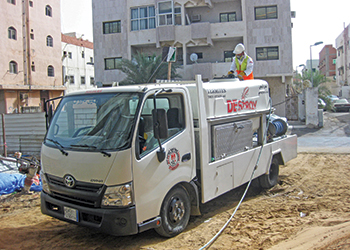
Masa ... providing a comprehensive pest extermination service for buildings pre- and post-construction.
Termiticides best bet for protection
01 September 2017
Termicides have evolved over the years to provide durable, effective and non-toxic protection to buildings, even before the commencement of construction, says MIRZA WAQAR AHMAD*.
Even though baits have been gaining popularity in recent years, termiticides – which are chemicals used to exterminate termites – remain the most widely used method worldwide for protecting constructions against subterranean termite.
While termiticides were introduced in the 1920s and 1930s, it was not until after the Second World War that a class of chemical compounds called cyclodienes was recognised as highly effective and became commercially available. Pre-construction soil treatments with this type of chemicals then became a regular method of subterranean termite prevention until the late 1980s. Cyclodienes, predominantly Chlordane, were extremely efficient and stable in soil, often protecting structures from subterranean termite infestation for several decades. However, doubts were raised about the environmental impact of these chemicals because of their residual longevity and by the 1980s, Chlordane and related chemicals were banned in most countries.
Following this move, the only termiticides offered for use as soil barrier treatments were either chlorpyrifos (belonging to the organophosphate class) or several pyrethroids. However, because of the poor residual action of chlorpyrifos, the US Environmental Protection Agency (EPA) cancelled its use as a soil termiticide (EPA, 2000).
This left pyrethroids as the primary weapon for subterranean termite management. Pyrethroids are less stable in soil than cyclodienes but more persistent than chlorpyrifos. Likewise, treated soil barriers composed of pyrethroids such as Permethrin and Bifenthrin are more likely to fail than those composed of cyclodienes or chlorpyrifos due to the repellent characteristics of pyrethroids to subterranean termites. Since 2000, several new non-repellant soil termiticides have been introduced on the market, such as Fipronil, a phenyl pyrazole (Aventis Corp, 2001), Imidacloprid, a chloronicotinyl (Bayer Corp, 2000), and Chlorfenapyr, a pyrrole (BASF Corp, 2001).
Hence basically, there are two major types of termiticides for soil treatment around constructions: the old class of repellent termiticides and the new non-repellent ones. Although there are pros and cons to both the methods of protection, both systems work well when used for the right application and in compliance with the manufacturer’s instructions.
The fast-acting, repellent toxicants include Bifenthrin and other pyrethroids that act as barriers to termite movement, while non-repellent, slower-acting compounds include Fipronil, Imidacloprid and Thiamethoxam, which are now among the preferred soil treatments (Wiltz, 2012). Delayed toxicity is expected to facilitate horizontal transmission of the active ingredient, possibly reducing termite activity. Research shows some evidence of colony destruction or elimination following perimeter treatments with Imidacloprid (Parman & Vargo, 2010).
 |
Al Sheieshakly ... owner of Masa. |
According to research conducted by Potter and Hillery in 2001, non-repellant termiticides have an advantage over the pyrethroids because subterranean termites cannot detect gaps in the treated soils while gaining access to the structures. Subterranean termites are unable to detect the termiticide and do not avoid the soil that has been treated with them.
A relatively new termiticide is Chlorantraniliprole, from the anthranilic diamide class of insecticides. This termiticide aims at the ryanodine receptor of termites, instigating the discharge of stored calcium, subsequently causing muscle control loss, interruption in feeding, and eventually the death of the termite (Cordova et al, 2006) (Dupont, 2010).
Almost all modern-age termiticides decompose over time while in contact with soil. Presently, the best products for this purpose last for as long as 10 years in the soil.
To avoid the losses caused by termite infestation, construction companies in many of the Gulf countries need to avail of termite-proofing services ahead of launching work on their buildings or other structures.
In general, pest control operators (PCOs) provide a 10-year guarantee for pre-construction and a five-year guarantee for post-construction termite treatments in Saudi Arabia. However, clients must inform the PCOs in case of any alteration to the building. The efficacy of termiticides is greatly affected by several variables and their true lifespan can only be accurately evaluated with the help of sophisticated scientific equipment.
Saudi-based Masa Establishment for Pest Extermination, Maintenance and Contracting – popularly known as Masa Pest Control – was set up by Mousaied Alshieshakly in 1980 who, with a team of management, specialists, and hard-working service personnel, established the pest and termite control business in Saudi Arabia’s construction industry, primarily in areas around the cities of Dammam, Riyadh and Jeddah, among others. The company’s focus is on achieving results and catering to customers’ needs.
Termites present a significant and constant threat to the value of any type of construction – be it homes, buildings, offices, or hospitals; Masa provides long-term protection to these structures by carrying out soil liquid treatments. Through pre-construction treatment, it eliminates the problems even before they occur. The product used for this purpose is Raslan Plus with the active ingredient Imidacloprid 30.5%, which is considered as moderately toxic by World Health Organisation (WHO). This non-repellent termiticide, which offers long-lasting protection from subterranean termites, is officially registered in Saudi Arabia and approved by the Saudi Food and Drug Authority (SFDA).
Based on its decades of experience, Masa Establishment recommends that construction companies seeking long-term termite protection for their constructions should first discuss the treatment options with an unbiased PCO that offers durable termite protection using approved termiticides. Masa’s pest control experts and specialists offer free inspections and a termite protection plan best suited to the client’s property.
• Mirza Waqar Ahmad is an entomologist at Masa Establishment, which is based in Jeddah, Saudi Arabia.


